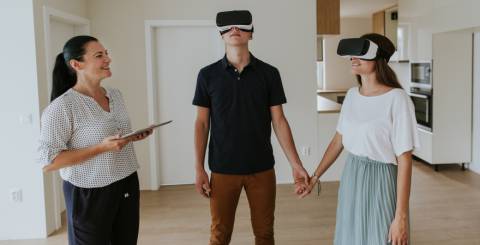5 Groundbreaking Ways of Applying Virtual Reality in Real Estate Marketing in 2020

The advent of virtual reality (VR) and its increasing use in the real estate industry is transforming the way how realtors are marketing real estate properties and helping prospects to make informed decisions. Gone are the days when real estate agents had to organize real-life property visits for prospective home-buyers after several rounds of explanations and negotiations. Today, real estate agents can effectively market a real estate property by showcasing VR-based demonstrations to prospective home-buyers. With a survey conducted by the National Association of Realtors suggesting that 44 percent of home-buyers search for properties online, real estate businesses should make sure that they deliver life-like virtual presentations that would allow them to showcase property-features in the best possible manner.
Using Virtual Reality in the Real Estate Sector
While VR is widely used in gaming and entertainment industries for a long time, real estate businesses, over time, have realized its true potential in designing awe-inspiring, hard-hitting marketing campaigns.
Here are top ways how VR can be creatively applied in the real estate industry:
1. Creating virtual property presentations
Prospective home-buyers visit multiple property sites in order to make a decision. This is a hectic process for both the real estate agents as well as their clients who often need to travel to a place that is far away from their homes. Personal visits to properties may prove to be time-consuming and costly affairs. When realtors develop presentations using VR technology, they allow their prospects to virtually visit properties. Using a VR headset, one can experience 3D walkthroughs of properties and can shortlist the properties that they feel are worth paying physical visits to.
3D virtual tours fall under two basic categories:
- Guided Visits: These types of virtual tours are traditional promotional videos that may appear as 360-degree walkthroughs or as completely virtual audio-visual content. These videos can be created very easily using a panoramic camera and they are ideal to promote existing properties. Notably, the creation of 360-degree videos does not demand the application of programming or advanced rendering techniques. However, prospective buyers are required to use VR headsets to gain an in-depth view of property-details.
- Interactive Visits: Interactive videos allow users to visit different parts of a property as per their wish by clicking on hotspots. The creation of interactive virtual home tours is difficult, but these presentations deliver better results than guided tours and allow realtors to showcase unique property-features in a detailed manner.
2. Applying virtual staging to provide a holistic view of a property
Images or videos of a vacant property that has no furniture present in it are less likely to attract the attention of the target audience. On the other hand, images of fully-furnished properties prove to be highly effective in generating positive sales response. According to a report published by the National Association of Realtors, 77 percent of real estate agents believe that virtual staging allows prospective home buyers to visualize how their future home might look like. Virtual staging demands significant cash outlay especially when newly-constructed properties are promoted. Fortunately, the use of VR technology to facilitate virtual staging is associated with nominal investments, which is why more and more real estate companies are opting for VR-based virtual staging. With VR, it is possible to create awe-inspiring 3D property tours that would generate life-like experiences.
- Visualizing a property before construction
It is quite difficult for real estate companies and agents to market a property before it gets constructed. By using 3D architectural visualizations, they can allow potential property buyers to get a clear idea about the overall architecture and to imagine how their future home would look like. Architects can use 3D renders of upcoming projects to evaluate designs and to detect structural flaws that might jeopardize project-success. The VR technology can be exploited well to design the indoor spaces of an upcoming property to allow prospective buyers to get a feel of their future residence.
- Communicating with tenants easily through virtual instructions
Landlords and realtors can create property-related demonstrations to allow their tenants to gain an overview of the properties that they have checked into. Tenants may often call landlords to know about the utilities that they can use and how they can use them. Owners of vacation rentals often experience such situations and this may prove to be quite frustrating to them. By getting 3D virtual tours designed, they can explain important property features in greater detail to their tenants and this way, they can escape the hassles that they might otherwise experience from repeated queries from their tenants.
- Enabling Virtual Commerce
VR enables commerce in the real estate sector. VR allows a homebuyer to make changes to a property’s interiors and to stylize a property as per his/her preferences. The homebuyer may visit an online store, select different furniture items, and then add them to the 3D virtual tour. If clients do not wish to make any change to the indoor spaces and they want to purchase all the items that are in showcased in the virtual tour, they can directly visit an online store and purchase them.
Ways How VR Technology Benefits the Real Estate Industry
VR technology is transforming the content delivery process in the real estate industry. We have summarized the top 5 benefits of using VR technology in real estate marketing:
1. Saves Time:
Realtors can arrange for virtual property tours at their offices, thereby eliminating the need to visit actual sites in person.
2. Establishes Emotional Bond:
Virtual tours of properties allow prospective homebuyers to visualize their future homes in a detailed manner. The immersive experience that 3D real estate walkthroughs create engages clients in a deeper level and promotes the development of a strong emotional connection.
3. Facilitates Global Reach:
With VR, realtors can showcase their projects to potential buyers who may be living in distant geographies. This way, realtors can reach a broader audience, deliver realistic property demonstrations, and increase the conversion rate.
4. Reduces Investment:
The creation of 3D virtual tours may appear to be a costly affair, but you will be surprised to know that traditional marketing involves higher cash outlays due to the fact that you would need to generate high-quality images as well as print collateral. On the other hand hand, the only resources that you would need to create virtual tours are a panoramic camera and basic rendering.
5. Instills a Feel of Ownership:
Real estate agents face challenges when it comes to negotiating with their clients or settling a purchase deal. Using VR-based, immersive presentations, real estate agents can instill a feeling of ownership in the minds of the potential homebuyers. Virtual tours can be enhanced through the incorporation of additional features such as mortgage calculators and information about other properties and neighborhoods. This would allow prospective buyers to get all relevant information and decide if they should really invest time and effort in visiting the actual property site.
Summing Up
There’s no doubt about the fact that VR will continue to shape the future of real estate marketing in a positive way. However, at present, only large real estate agencies have started capitalizing on the benefits that VR has to offer. More real estate agents are expected to join the crowd and leverage the potential of VR to improve their efficiency.
Similar Articles
Consumers today engage with brands through multiple touchpoints, including websites, social media, email, messaging apps, and in-store interactions.
Modern businesses survive in cutthroat competition. So, a strong brand identity is more crucial than ever. Having an eye-catching logo is not enough. Your brand is the face of your business - it reflects your values, mission, and unique selling points. A strong, memorable brand helps customers easily recognize your business and encourages repeat purchases.
Check out this article to discover how marketing analysis can help you become better than competitors in business, with the necessary steps to analyze your competition.
Now that the world has gone digital with tons of advancements being achieved in the past decade, businesses are always on the lookout for new ways to reach out to consumers. Meet chatbot marketing — a phenomenon that has become a major disruptive innovation in the industry, changing the way brands communicate with the audience and generate revenue
After securing seed funding for your newly launched startup, the next challenge for you is to gain more market visibility. Securing high-profile press coverage can help you build credibility and achieve the exposure needed to attract more investors, customers, and potential audiences.
Improving your online presence requires more than just a visually appealing website.
Today, when the markets have become highly competitive, grabbing the attention of potential audiences and communicating a brand's message is more challenging than ever. Nowadays, consumers are bombarded with a lot of information from numerous online sources, making it vital for businesses to stand out from the competition.
Expanding your Amazon business into global markets presents a lucrative opportunity to reach new customers and drive substantial growth. However, navigating international expansion requires careful planning, strategic execution, and leveraging the right tools.
Did you recognize that there are almost 2 million small and medium-sized businesses selling on Amazon in the world? While this is wonderful information for consumers, it is not so positive for sellers who are having a hard time obtaining their products to stand out from the group.









